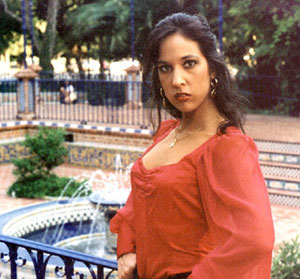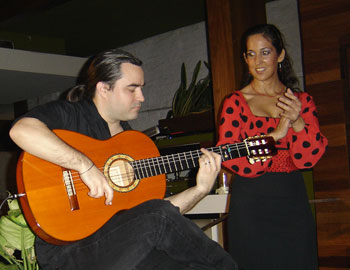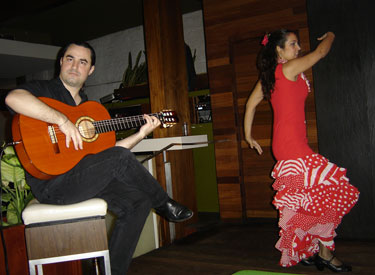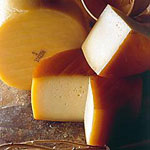
Introducing Flor Pérez Taboada
 April 10, 2008 Sometime last Fall I interviewed Flor on a cold Saturday at the DC Dance Collective. She had recently arrived to the DC area. Flor contacted me via email about the DC flamenco scene and I agreed to meet up with her and offered my assistance in getting her settled into the local community. My original plan was to take some publicity shots of her class but because of the snow that day and the fact that not too many people knew about her yet, nobody showed up. But since we were both there sitting comfortably on the couches at the DC Dance Collective with nothing else to do, I pulled out my digital voice recorder and did a quick informal interview on-the-spot.
April 10, 2008 Sometime last Fall I interviewed Flor on a cold Saturday at the DC Dance Collective. She had recently arrived to the DC area. Flor contacted me via email about the DC flamenco scene and I agreed to meet up with her and offered my assistance in getting her settled into the local community. My original plan was to take some publicity shots of her class but because of the snow that day and the fact that not too many people knew about her yet, nobody showed up. But since we were both there sitting comfortably on the couches at the DC Dance Collective with nothing else to do, I pulled out my digital voice recorder and did a quick informal interview on-the-spot.
Miguelito: Where did you begin your flamenco studies?
Flor: I started in Argentina fifteen years ago and after five years I decided I wanted to go to Seville because in Argentina I had already studied with everyone and was ready to do something more professional. The first time I went to Seville it was for three months. When I returned again to Argentina we were very fortunate that Spanish teachers were starting to come all the time. For example, one month was La China, the next month was Isabel Bayón. For a couple of years, having all these Spanish teachers here made it feel like were like living in Madrid. Every now and then I would go to Seville sometimes for three months, four months or six months. When you add it all up, it was about a year. The Seville style is what I like the most. Of course, I went to Jerez and learned about bulería de Jerez.
In Madrid I didn't like the classes as much because I think it's a very different style. I studied with Joselito Maya Romero. Every time he was teaching I was with him. But I didn't try a lot of teachers in Madrid.
M: Whom did you study with in Sevilla?
F: It's a long list!
M: Give me a short list.
F: Manuela Ríos, Torombo, Concha Vargas, Manolo Marín, Toná and Juana Maya. Most of all it was Manuela Ríos. I was doing private classes with her because she was unknown at the time. It was like ten years ago. So it was the first time someone was asking her to teach. And she was like, "Oh I don't know. I'm not a maestra." So I said, "OK, but I like your style very much." And now she's teaching a lot. At that moment, she wasn't so expensive to take private classes. That was great because I was by myself and she was giving me all the tips to get the Seville style. But I also love Torombo, his philosophy, the way he talks in the class helped me a lot to understand a lot of things.
M: What brought you to Washington DC?
F: My husband was transferred. He worked in a hotel that's nothing to do with flamenco. And he was working in Madrid and that hotel closed. So we had to move. That brought me here.
When I lived in New York, I was by myself. I was single. I had a best friend from Argentina and she had an apartment in New York. I just had appendix surgery and had to rest for one or two months. So she said come and you will live at my house. And when I was there I wanted to rest from flamenco but one day I visited a flamenco tapas bar. I was curious about the flamenco in New York. So I went. And that day everybody was telling me, "Why don't you dance because if you dance there you will be something new. It's always the same people. You will find work in all the tablaos here.” And somebody from Argentina gave me all the names and telephone numbers. Five days before I was going back to Argentina and I called this one tablao and they said I could come and they’d give me a month contract at Mesón Flamenco--it was the main place at that time. Now it's closed. It was a very nice offer and my best friend offered to let me stay in her house again. So I came back and I was working there and all in all it was two years. I started school. I was working. I was doing my own small company. It's a different situation then now.
M: Tell me about your teaching style, you teaching philosophy, how you do your classes.
 F: That's something that I'm trying to change now. I was always teaching beginners before. And I was working a lot with the technique of María Magdalena and now I want to do something more, not technique or choreography. I want to work with people that are more intermediate or advanced, ones that already know more or less how to dance. But they want to know something more about how to find their own style, how to create their own choreography, how to improvise. Things like knowing the traditional structure of alegría for example while not being such a slave to the teacher's choreography. If you don't finish the choreography in the class you can still work with it. They should be able to take their favorite steps from various teachers and put them all together. Things that will help to find your own style and inspire you to create your own choreographies.
F: That's something that I'm trying to change now. I was always teaching beginners before. And I was working a lot with the technique of María Magdalena and now I want to do something more, not technique or choreography. I want to work with people that are more intermediate or advanced, ones that already know more or less how to dance. But they want to know something more about how to find their own style, how to create their own choreography, how to improvise. Things like knowing the traditional structure of alegría for example while not being such a slave to the teacher's choreography. If you don't finish the choreography in the class you can still work with it. They should be able to take their favorite steps from various teachers and put them all together. Things that will help to find your own style and inspire you to create your own choreographies.
Also I was studying theatre and musical theatre. And it helped me a lot to learn how to be onstage in a different way than what you learn just by going to flamenco class. How to get up from the chair, how to project your energy. Being onstage is another part of what I want to work on in class. How to walk onstage. How to feel the space. I also will work with the choreographies because you need the material to explain the different ideas. But I will go into how people dance with weight, with peso. What can you do to get that sensation? Being more flamenco or more modern or andaluz. Small things that you don't usually see in a class. There are things that I have learned with my experience but nobody told me. And now I can pass on this knowledge. But I don't want to do a very technical class like a lot of footwork. But I know this is all very abstract so I'm afraid that people won't understand. So I want people to try it. Come and try one class so they see how it is.
When I started, the teacher had no levels. So I was doing my first classes and it was for soleá and the students with me were dancing for six years and it was my first month. But it was a good thing because I didn’t have in my mind, "OK if I'm a beginner I have to do Sevillanas and then the following year I will do tangos." It’s not really necessary to go about it that way because for me it was simply like, "What is a soleá?" And I was learning every movement alongside the more advanced dancers. It was more natural. It was like a Montesorri. Now my baby is going to Montesorri and they put all the students of all ages together. The younger ones follow and interact with the older ones. So that’s how it was for me. But I think that when you are a beginner, you still need to focus on how to do planta, tacón, golpe and how to move your hands, just basics of technique.
M: Do you think there is a way to teach about cante in the beginning stages or is it better to wait until later on?
 F: I think you have to explain to the students that there is more than one way to do a choreography. You have to explain when you need a llamada, when you need the cante, when you need the cierre, escobilla. However, nowadays it's not so strict. You can change things. You can mix different palos. Still you have go back to the traditional structure for beginners because for them it will be crazy if they think they can change anything.
F: I think you have to explain to the students that there is more than one way to do a choreography. You have to explain when you need a llamada, when you need the cante, when you need the cierre, escobilla. However, nowadays it's not so strict. You can change things. You can mix different palos. Still you have go back to the traditional structure for beginners because for them it will be crazy if they think they can change anything.
In my description for the class I start by asking, “How can one do a tablao show with no rehearsal?” You have to very clear in the structure of your dance so that the musicians can follow you. You cannot have some arrangements like, "When I do this, you stop and when I do this, you sing." You have to be very clear in your dancing. The other thing is that you have to learn how to mandar on the stage. If the musicians feel that you are confident and that you are secure they're going to follow.
At the beginning when I started dancing I was afraid to lead because I was like, "I'm nobody. They know a lot and they've been musicians longer than I've been a dancer." So I was not very secure. So at the end I discovered that it's easier for everybody if you are more clear, even assertive. They need that. It's easier for everybody. In that moment, that's what we call mandar en el escenario. In flamenco it's to be very clean and to be very clear for example when you want to communicate, "Now I want to speed up." Of course, you do it in compás little by little and they will understand if they're good musicians because if not then it will be a mess. But if everybody knows what they have to do, the singer knows where to come in and if he doesn't know, you can turn and say, "Sing!" but ideally you have to know how to communicate through your dancing without having to say it verbally. There are things you learn when you perform and when you work with different musicians. So it's not so bad when that happens. It’s a learning experience.
M: What do you want to do artistically here in DC? Do you want to eventually start a company?
F: I don't want to start a company. I'm in a situation where I'm not very sure what I want to do. Lately I have an interest in the production side of putting on shows as well as artistic direction because I love to design the dresses, lights and the program and the carteles. I love all that, sometimes more than when I have to dance. [Laughs.] I love to dance but I also love the whole theatre thing. But I will leave in two years. So I don't know if I have the time to build-up a company. So maybe I can do things little by little here with people that are already established, help them or they can help me and we can do some things together. But I'm not going to stay here very long.
[Editor's note: for more info about classes and performances, visit Flor's website.]
There's more! Previously published articles are on page two.
Text and original images ©1996-2013 by . Please do not republish content from this website, including text and photos, in whole or part without prior written permission.





